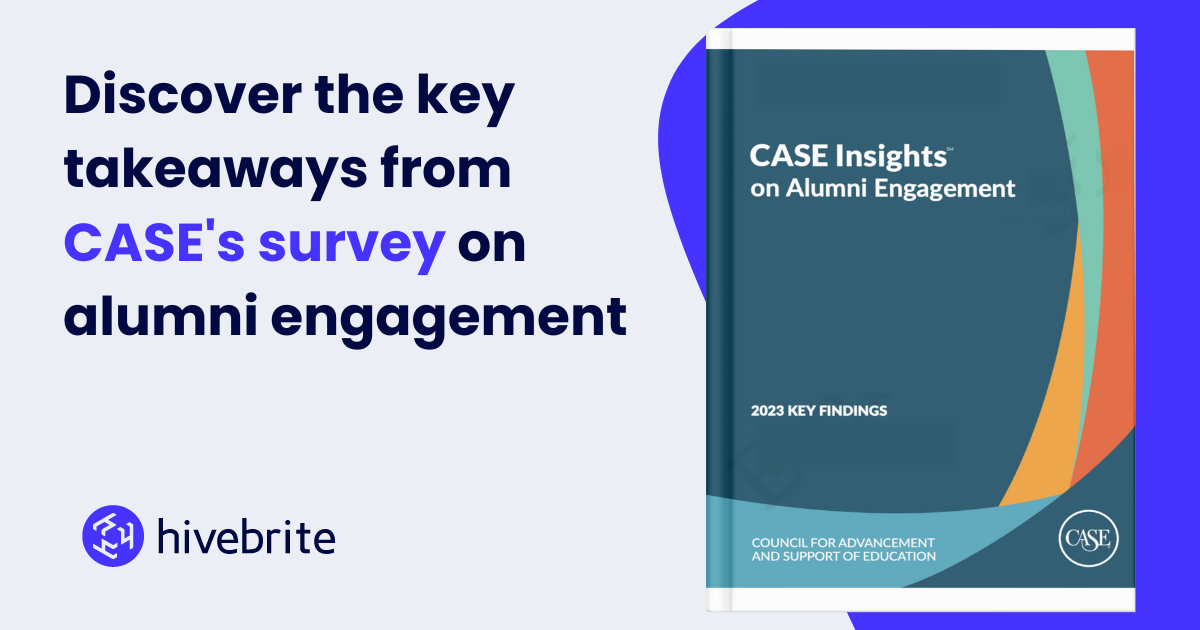The CASE Insights on Alumni Engagement survey is a valuable tool for institutions to evaluate alumni engagement across four key areas: communication, events, philanthropy, and volunteering.
The survey enables institutions to compare their alumni engagement data with peers and regional trends, aiding in strategic planning and improving engagement practices.
You can download the full report here or keep scrolling for our three key takeaways!

What is alumni engagement?
Alumni engagement encompasses activities that foster a meaningful and measurable connection between an institution and its alumni, supporting the institution’s mission and strategic goals. CASE’s survey categorizes alumni engagement into four primary modes:
- Communication
Communications involve interactive, meaningful, and informative exchanges with alumni that bolster your school’s mission, goals, and reputation. This includes active engagement on social media, such as likes and comments, and reciprocal email correspondence. Note that passive activities like receiving a mailed publication or email are not considered communication engagements by CASE. - Experiential
Experiential engagements provide meaningful interactions that inspire alumni and celebrate the school’s mission and accomplishments. These include both in-person and virtual activities like events, reunions, online book clubs, and digital forums. - Philanthropy
Philanthropic opportunities allow alumni to contribute financially or through in-kind support to advance the school’s mission and strategic goals. This includes various forms of monetary donations and material contributions. - Volunteering
Volunteer roles are structured and fulfilling positions that align with and support your school’s mission and strategic objectives. They include serving on boards or advisory committees, mentoring students, advocating publicly, and speaking in classrooms.
Each mode plays a distinct role in alumni engagement, and successful strategies often combine multiple modes to maximize impact.
3 key takeaways from CASE Insights on Alumni Engagement
1. Engagement patterns by graduation cohort
Alumni engagement patterns vary significantly by graduation cohort.
Communication engagement is highest in the first five years post-graduation and then declines.
Experiential engagement also peaks early but sees a resurgence later. Similar to communication engagement, experiential engagement is a likely precursor to philanthropic engagement.
Given the time and effort required to volunteer formally, every cohort has a low engagement rate. Essentially, one percent of alumni volunteer in every cohort.
Philanthropic engagement, however, increases steadily with alumni age.
Actionable takeaway: Develop targeted engagement strategies for each cohort. Focus on communication and experiential engagement for recent graduates to maintain their connection. Gradually introduce philanthropic opportunities as alumni age, leveraging their increasing capacity and willingness to give.
2. Regional variations in engagement
Alumni engagement strategies need to account for regional differences. For instance, philanthropy is more prominent in some regions, while experiential engagement is more common in others.
Understanding these regional nuances can help tailor more effective engagement strategies.
Actionable takeaway: Customize engagement strategies to fit regional preferences and cultural norms.
Conduct regional surveys or focus groups to gather specific insights and adjust your approach accordingly. For example, prioritize philanthropic appeals in regions with a strong giving culture and focus on events and volunteer opportunities in regions where those are more popular.
3. Challenges in data collection and reporting
Institutions report varying levels of confidence in their data for different engagement modes. While philanthropic engagement data tends to be more reliable due to established tracking systems, communication and experiential engagement data are often less robust.
Actionable takeaway: Invest in improving data collection and reporting mechanisms. Implement comprehensive CRM systems that capture all forms of engagement, train staff on accurate data entry, and regularly audit data quality.
Clear definitions and consistent tracking will enhance the reliability of engagement metrics.
Are you looking for more alumni engagement ideas? Download The Alumni Connection. It shares practical advice and personal experiences from thought leaders in the field to inspire advancement professionals to think creatively and strategically about alumni engagement.